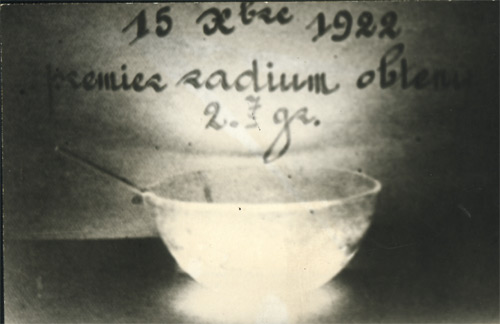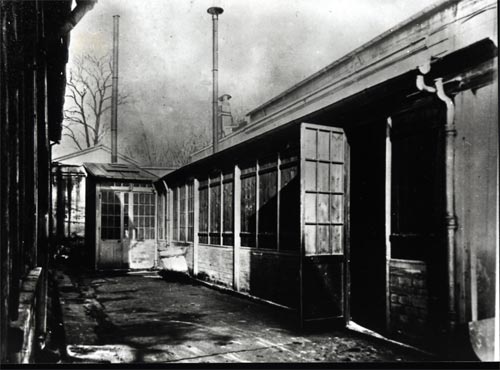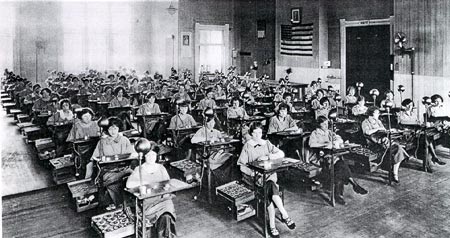The radioactive nucleus that made History

The radium bowl
Luminescent bowl of radium bromide, photographed in 1922: Bowl containing radium bromide, photographed in the dark at some point in 1922. Radium is about a million times more radioactive than uranium and, under the influence of the heat released, emits an attractive blue colour that Pierre and Marie Curie enjoyed looking at in the evenings.
© ACJC
Radium is an extremely rare element that was first discovered in 1898 by Pierre and Marie Curie. They also measured its mass and atomic number, and were able to show that it filled an empty space in Mendeleyev’s periodic table. Five years after Pierre Curie’s death in 1906, Marie Curie was awarded with a second Nobel Prize in 1911 for her discovery of radium: a prize in chemistry, this time, making her the first woman to be awarded with a Nobel Prize in this particular field.
The new element was called radium, found to have 88 protons and a variety of isotopes. The most important one, radium 226, is an alpha and gamma emitter with a half-life of 1600 years.

The rue Lhomond hangar
Exterior of the ‘hangar’ of the Ecole de Physique et de Chimie de la Ville de Paris, then at 42 rue Lhomond, where Pierre and Marie Curie first isolated polonium and radium from a uranium ore known as pitchblende. Almost 400 tonnes of pitchblende had to be processed for one gram of uranium to be produced.
© ACJC
https://laradioactivite.com/glossaire/biological-half-life
Traces of radium 226 can be found in uranium ore – of the order of one atom per three million. This particular radioisotope is the fifth radioactive descendant of uranium 238, which in turn transforms into a radioactive noble gas, radon 222, with a half-life of 3.8 days.
The Curie , the activity of 1 radium gram (equivalent to about 37 billion disintegrations per second), was for many years the standard unit for measuring activity. This gram of radium was the quantity that Marie Curie was painstakingly able to obtain at her rue Lhomond laboratory.
During the 1920s, the public suddenly went crazy for radium. Whereas the dangers of radioactivity are often exaggerated today, at the time none of the risks had even been considered.

The »dials painters » workshop
View of the workshop where, in the 1920s, young Americans painted alarm clock dials. The luminescent paint which contained traces of radium caused throat cancer in the workers who moistened the brushes with their tongues. It took time, tragically, once the cause of the cancers had been identified, to impose the necessary measures on the manufacturer.
© DR
As a result, one of the first uses found for radium was in luminous paint for watches, alarm clocks and compasses. In 1924, a New York doctor was surprised to find signs of jaw cancer in a large number of young women who worked in the luminous paint industry. It eventually occurred to him that the women had been licking the tips of their paintbrushes – causing them to ingest harmful quantities of radium. Marie Curie soon realized the potential dangers of her new discovery, and helped put an end to this harmful profession.
Radium was used to cure cancers for decades before finally being declared unsafe in 1976 and gradually replaced with iridium 192 and caesium 137 for brachytherapies.
1921 …Recycling obsolete radium sources to treat cancer
Today, since 2021, the International Atomic Energy Agency (IAEA) has been leading a global initiative to recycle old sources of radium-226. These materials now obsolete, once used in radiotherapy, can be transformed into actinium-225, a rare and promising radioisotope for targeted alpha therapy against cancer. In June 2025, Tunisia transferred more than 100 sources to the United States, and Brazil is preparing to send nearly 400 others, of which some were donated over 80 years ago by Marie Curie herself.
This project illustrates how a circular economy can be applied to the nuclear sector : To give a second life to radioactive sources to perform new cutting-edge medical treatments. Thanks to an international cooperation, other countries will soon join this program, strengthening security and management of radioactive waste while giving access to new tools for the fight against cancer (Cf. AIEA article )
ABOUT THE RADIUM USES AFTER THE DISCOVERY :
– 1) : 1920’s : the radium follies
– 2) : The later uses of radium
Other articles on the subject « Main Radioactive Nuclei »
Uranium 238 and 235
A radioactive and strategic element The uranium atom is the heaviest atom present in the natural [...]
Plutonium 239
Plutonium 239: an artificial fissile nucleus, highly sought-after and feared Plutonium, the ninet[...]
Plutonium Properties
A transuranic element with long-lived radiotoxic isotopes Plutonium is a very dense metal, radioa[...]
Carbon-14
A by-product of cosmic rays Carbon-14 (C-14) formation in the atmosphere The nucleus of carbon-14[...]
Potassium-40
A curiosity of Nature and a very long lived beta emitter Potassium 40 is a radioisotope found in [...]
Iodine 131
Radioactive iodine : A dangerous and short lived fission product Iodine 131 is a radioisotope wit[...]
Tritium
A radioactive isotope of hydrogen Tritium is a beta-emitting radioactive isotope of hydrogen. Its[...]
Caesium 137
A legacy of atmospheric nuclear bomb tests and accidents Caesium 137 is a radioactive element wit[...]
Strontium-90
A fission product with properties close to calcium Strontium-90 is with cesium-137 a major radioa[...]
Technetium 99
A pure gamma emitter widely used in nuclear medicine Of all the atoms below uranium in Mendeleyev[...]